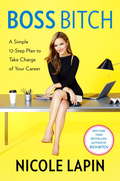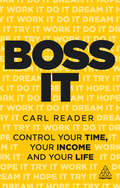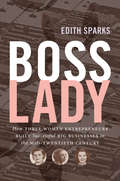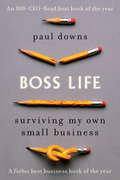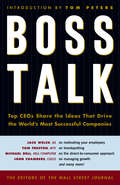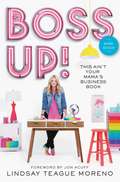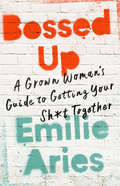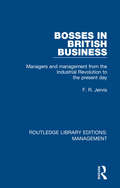- Table View
- List View
Boss Bitch: A Simple 12-Step Plan to Take Charge of Your Career
by Nicole Lapin<p><i>New York Times</i> bestselling author Nicole Lapin is back with a sassy and actionable guide empowering women to be the boss of their lives and their careers. <p>You don’t need dozens of employees to be a boss, says financial expert and serial entrepreneur Nicole Lapin. Hell, you don’t even need one. You just need to find your inner Boss Bitch — your most confident, savvy, ambitious self — and own it. <p>A Boss Bitch is the she-ro of her own story. She is someone who takes charge of her future and embraces being a “boss” in all aspects of the word: whether as the boss of her own life, family and career, the literal boss at work, or, as the boss of her own company. Whichever she chooses (or all three), a Boss Bitch is someone who gets out there and makes her success happen — and so can you. <p>Lapin draws on raw and often hilariously real stories from her own career — the good, the bad, and the ugly — to show what it means to be a "boss" in twelve easy steps. In her refreshingly accessible and relatable style, she first shows how to embrace the “boss of you" mentality by seizing the power that comes from believing in yourself and expanding your skillset. Then she offers candid no-nonsense advice for how to kill it at as the “boss at work” whether you have a high-up role or not. And finally, for those who want to take the plunge as an entrepreneur, she lays out the nuts and bolts of how to be the “boss of your own business” from raising money and getting it off the ground to hiring a kickass staff and dealing office drama to turning a profit. <p>Being a badass in your career is something that should be worn as a badge of honor, says Lapin. Here, she inspires us to rise to the occasion and celebrate our successes — and then keep killing it like the Boss Bitches we are!</p>
Boss It: Control Your Time, Your Income and Your Life
by Carl ReaderDo you dream of ditching the day job, doing your own thing and being your own boss? Are you ready to Boss It? In this invigorating and highly practical book, serial entrepreneur Carl Reader provides exactly the fire and guidance you need to get started. Designed to cut through the business jargon, this handy guide will take you through everything you need to establish and run your own business - from the mindset it takes to turn a dream into a plan, to the need-to-know practical stuff for running and growing a business. Featuring case studies, templates and exercises to help you put what you read into action, and turn that dream into a reality, this motivational book will enable you to be your own boss, to take control of your income, your time and your life... and Boss It.
Boss Lady: An Executive Woman Talks About Making It
by Jo FoxworthIn the United States when this was published (1978), as stated on the back cover: "College-educated men average $20,000 a year; college women get only $12,000. Our work force is over 40% female, yet women hold only 6% of the managerial positions. When a woman who has made a place in that 6% for herself is ready to tell you how--it’s smart to listen to the Boss Lady." The Boss Lady is Jo Foxworth, an American advertising executive who started as a copywriter in 1955, and then founded her own advertising firm in 1968. Although the times have changed since then, and the three-martini business lunch is no longer common practice, much has NOT changed for women in the business world. Writing in a straightforward, highly readable style, Ms. Foxworth offers up plenty of still-useful tips for women who strive to become successful business executives.
Boss Lady: How Three Women Entrepreneurs Built Successful Big Businesses in the Mid-Twentieth Century (The Luther H. Hodges Jr. and Luther H. Hodges Sr. Series on Business, Entrepreneurship, and Public Policy)
by Edith SparksToo often, depictions of women's rise in corporate America leave out the first generation of breakthrough women entrepreneurs. Here, Edith Sparks restores the careers of three pioneering businesswomen--Tillie Lewis (founder of Flotill Products), Olive Ann Beech (cofounder of Beech Aircraft), and Margaret Rudkin (founder of Pepperidge Farm)--who started their own manufacturing companies in the 1930s, sold them to major corporations in the 1960s and 1970s, and became members of their corporate boards. These leaders began their ascent to the highest echelons of the business world before women had widespread access to higher education and before there were federal programs to incentivize women entrepreneurs or laws to prohibit credit discrimination. In telling their stories, Sparks demonstrates how these women at once rejected cultural prescriptions and manipulated them to their advantage, leveraged familial connections, and seized government opportunities, all while advocating for themselves in business environments that were not designed for women, let alone for women leaders.By contextualizing the careers of these hugely successful yet largely forgotten entrepreneurs, Sparks adds a vital dimension to the history of twentieth-century corporate America and provides a powerful lesson on what it took for women to succeed in this male-dominated business world.
Boss Life
by Paul DownsWhen columnist Paul Downs was approached by The New York Times to write for their "You're the Boss" blog, he had been running his custom furniture business for twenty-four years strong. or mostly strong. Now, in his first book, Downs paints an honest portrait of a real business, with a real boss, a real set of employees, and the real challenges they face. Fresh out of college in 1986, Downs opened his first business, a small company that builds custom furniture. In 1987, he hired his first employee. That's when things got complicated. As his enterprise began to grow, he had to learn about management, cash flow, taxes, and so much more. But despite any obstacles, Downs always remained keenly aware that every small business, no matter the product it makes or the service it provides, starts with people. He writes with tremendous insight about hiring employees, providing motivation to get the best out of them, and the difficult decisions he's made to let some of them go. Downs also looks outward, to his dealings with vendors and to providing each client with exemplary customer service from first sales pitch to final delivery. With honesty and conviction, he tells the true story behind building and sustaining a successful company in an ever-evolving economy, often airing his own failures and shortcomings to reveal the difficulties that arise from being a boss and a businessperson. Countless employees have told the story of their experience with managers--Boss Life tells the other side of that story. shortcomings to unveil the difficulties that arise from being a boss and a business person. We've heard countless stories from employees about their managers; Boss Life seeks to tell the other side of that story.
Boss Talk
by Wall Street JournalTimeless and effective business lessons from twenty-one top CEOsEvery business leader--from manager to entrepreneur--wants to know the ideas that motivate and inspire the world's most successful CEOs. Boss Talk presents twenty-one CEOs who give expert advice on issues important to today's businessperson. The topics include:*Motivating Your Employees*Managing Growth*Building a Brand*Learning from the New Economy*Trendspotting*Beating the Competition*Leading a Successful Turnaround or TransitionHere's what some bosses are talking about:"You have to get rewarded in the soul and in the wallet. The money isn't enough, but a plaque isn't enough either."--Jack Welch, General Electric Co."Lead by example. If you do that as CEO, your style will filter down through your team."--John Chambers, Cisco Systems"We do a lot of quantitative stuff. But coupled with that is having an employee staff and culture that is inherently interested in what we do."--Tom Freston, MTV Networks"Surround yourself with people you trust. You can't run a business over a certain size and sign off on everything."--Emily Woods, J.CrewFrom the Trade Paperback edition.
Boss Up!: This Ain’t Your Mama’s Business Book
by Lindsay MorenoBoss Up! will help you put your business on the map and the ideas you’ve previously only dreamed about into the marketplace. It will help you overcome your fears and guilt to find a fulfillment that changes you and your families for the better. And it will help you break free of the hard and boring and allow you to have fun along the way. <p><p> In Boss Up! Lindsay helps you gain the confidence to know that having ambition doesn’t make you a bad mother or wife. That it’s okay to have a desire for something more than endless sippy cups, clean-ups, Band-Aids, and groundings. That no matter your education or experience, you can tap into your passions and create businesses that give you increased flexibility, fulfillment, and financial security. And Lindsay doesn’t just do this through commiserating but, instead, through giving you the tools for change. Using the lessons she learned on her own path to success, Lindsay shares real, solid business principles with ten distinct success philosophies that you will encounter on the journey to entrepreneurship. <p> Stay-at-home mom turned multimillion-dollar-producing business owner Lindsay Teague Moreno doesn’t just have a passion for entrepreneurship. She has a deep passion for helping women of all walks of life gain the confidence and skills to tap into their ambition and achieve success in their own business endeavors.
Bossed Up: A Grown Woman's Guide to Getting Your Sh*t Together
by Emilie AriesIn this candid, refreshing guide for young women to take with us as we run the world, Emilie Aries shows you how to own your power, know your worth, and design your career and life accordingly. Young women today face an uncertain job market, the pressure to ascend at all costs, and a fear of burning out. But the landscape is changing, and women are taking an assertive role in shaping our careers and lives, while investing more and more in our community of support. Bossed Up teaches you how to:Break out of the "martyrdom mindset," and cultivate your Boss Identity by getting clear on what you really want for your career and life without apology;Hone the self-advocacy skills necessary for success;Understand the differences between being assertive (which is part of being a leader) and being aggressive (which is more like being a bully) - and how that clarity can transform your trajectory;Beat burnout by identifying how the warning signs may be showing up in your life and how to prioritize bringing more rest, purpose, agency, and community to your day-to-day life;Unpack the steps to cultivating something more than just confidence; a boss identity, which will establish your ability to be the boss of your life no matter what comes your way.Drawing from timely research, and with personal stories, and spotlights on a diverse group of women from the Bossed Up community, this book will show you how to craft a happy, healthy, and sustainable career path you'll love.
Bosses in British Business: Managers and Management from the Industrial Revolution to the Present Day (Routledge Library Editions: Management #38)
by F. R. JervisIn this volume, first published in 1974, the author provides an introduction to the historical development of management in business. Success and failure in a commercial world can be explained partly in terms of economic forces, but much also depends on the people, on the management of the firms – on the bosses. The author approaches this topic by examining some of the major companies and individuals over the past two hundred years, and examines how apparently secure and profitable companies at times run into great difficulties and shows that, by examining the reasons for success and failure, pitfalls may be avoided and efficiency improved. This book will be of special value to business and commercial students, as well as to the general reader who is interested in the problems of modern industry.
Boston Automation Systems, Inc.
by David F. HawkinsDaniel Fisher, the CFO of Boston Automation Systems, must review a number of revenue transaction accounting policies following the issuance of the Securities and Exchange Commission's Staff Accounting Bulletin 101, "Revenue Recognition in Financial Statements." Teaching Purpose: To explore the earned and realized criteria for recognition of revenue.
Boston Beer Co., Inc.
by Amy P. Hutton Christopher CharronCapital markets may have overcapitalized the craft brewing industry during a flurry of new IPOs. In the context of this "hot" IPO market each individual company's valuation may seem reasonable. However, after careful analysis of each company's financial statement and upon consideration of analysts' forecasts of the industry's growth prospects, it is unclear whether the craft brewing industry is overcapitalized. This could be another "hot" then "crash" IPO industry, like biotech or the computer disk drive industry.
Boston Beer Co.: Light Beer Decision
by Michael J. Roberts Joseph B. Lassiter Linda A. CyrBoston Beer's current light-beer offering, Boston Lightship, has not been successful, and a student team is charged with investigating the problem and recommending a strategy. Highlights issues around branding, target customer selection, and cannibalization, and introduces the ZMET. Includes color exhibits.
Boston Chicken, Inc.
by Paul M. HealyThis case examines Boston Chicken's franchise strategy for growing its innovative restaurant business, and the associated accounting reporting issues that arise.
Boston Children's Hospital: Measuring Patient Costs
by Robert S. Kaplan Mary L. Witkowski Jessica A. HohmanThe case describes two pilot projects on applying activity-based costing to measuring the cost of treating patients. It presents process maps and financial data relating to the processes used during (1) an office visit to a plastic surgeon for three different diagnoses, and (2) application and removal of three different casts in the orthopedic cast room. Students calculate and compare the costs and margins of the three procedures at the two different sites using the hospital's existing cost system and a proposed new system based on time-driven activity-based costing.
Boston Children's Hospital: Measuring Patient Costs
by Robert S. Kaplan Mary L. Witkowski Jessica A. HohmanThe case describes two pilot projects on applying activity-based costing to measuring the cost of treating patients. It presents process maps and financial data relating to the processes used during (1) an office visit to a plastic surgeon for three different diagnoses, and (2) application and removal of three different casts in the orthopedic cast room. Students calculate and compare the costs and margins of the three procedures at the two different sites using the hospital's existing cost system and a proposed new system based on time-driven activity-based costing.
Boston Children's Hospital: Measuring Patient Costs (Abridged)
by Robert S. KaplanThe case describes a pilot project on applying activity-based costing to measure the cost of treating patients. After an overview of Boston Children's Hospital and its local health care market environment, the case presents process maps and financial data relating to patients making office visits to a plastic surgeon for three different diagnoses. Students use the hospital's existing cost system and a proposed new system, based on time-driven activity-based costing, to calculate and compare costs and margins of the three types of office visits.
Boston Children's Hospital: Measuring Patient Costs (Abridged)
by Robert S. KaplanThe case describes a pilot project on applying activity-based costing to measure the cost of treating patients. After an overview of Boston Children's Hospital and its local health care market environment, the case presents process maps and financial data relating to patients making office visits to a plastic surgeon for three different diagnoses. Students use the hospital's existing cost system and a proposed new system, based on time-driven activity-based costing, to calculate and compare costs and margins of the three types of office visits.
Boston Children's Hospital: Measuring Patient Costs (V)
by Robert S. Kaplan Mary L. Witkowski Jessica A. HohmanCase
Boston Children's Hospital: Measuring Patient Costs (V)
by Robert S. Kaplan Mary L. Witkowski Jessica A. HohmanThe case describes two pilot projects on applying activity-based costing to measuring the cost of treating patients. It presents process maps and financial data relating to the processes used during (1) an office visit to a plastic surgeon for three different diagnoses, and (2) application and removal of three different casts in the orthopedic cast room. Students calculate and compare the costs and margins of the three procedures at the two different sites using the hospital's existing cost system and a proposed new system based on time-driven activity-based costing.
Boston Duck Tours--1996: Has Boston Gone Quackers?
by Myra M. Hart Stephanie DodsonWhile on vacation in Memphis, former investment manager Andy Wilson discovers a unique "tour bus" that travels over land and through water. He decides to transplant the concept to Boston and to add both historical and theatrical features to the amphibious tour. As he tries to start up Boston Duck Tours, Wilson must figure out how to organize and fund the new venture. The challenges seem overwhelming. He has no relevant experience and very little money. The market is untested and, at best, seasonal. Furthermore, the regulatory barriers are high. Wilson's persistence and creativity provide some solutions, but create additional challenges when it comes to harvesting financial value. This case is particularly useful in the Resourcing and Organizing module of a course on New Ventures.
Boston Fights Drugs (A): Designing Communications Research
by V. Kasturi Rangan Jennifer LawrenceDescribes in detail the research mounted by five individuals with a $20,000 budget to combat drug abuse among Boston's school-going population. Using the focus group methodology they discover that most of the current anti-drug advertising is useless. They create their own storyboards but are not sure if they are truly better.
Boston Fights Drugs (B): Converting Research to Action
by V. Kasturi Rangan Jennifer LawrenceDescribes the results of the advertising pre-test described in the (A) case. The group must now decide how to implement its findings for maximum impact.
Boston Lyric Opera
by Robert S. Kaplan Dennis CampbellThe Boston Lyric Opera was the fastest growing opera company in North America during the 1990s. Having successfully completed a move to a larger facility in 1999, the board and general director recognize the need to develop a formal strategic planning and governance process to guide the company into the future. Board members, senior managers, and artistic leaders use the Balanced Scorecard (BSC) as the focus of a multi-month strategic planning process that develops a strategy map and objectives in the four BSC perspectives for three core strategic themes. This case describes the high-level scorecard development, its cascading down to departments and individuals and the directors' interactions--using the Balanced Scorecard--with the artistic leaders and board of directors.
Boston Public Schools' Long Term Financial Plan
by Victor Wu C. Fritz Foley F. Katelynn BolandIn the fall of 2016, the senior leadership team of Boston Public Schools prepared a report indicating that costs were expected to grow faster than revenues for many years to come. They faced questions about whether the projections would be believed and about how to present, prioritize, and implement potential reforms that would help balance the budget.
